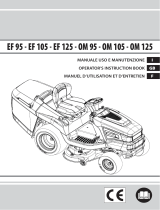
GB
15
TRANSLATION OF ORIGINAL INSTRUCTIONS
TO OUR VALUED CUSTOMERS
Thank you for selecting an Emak product. Our network of
dealers and authorized workshops will always be at your
complete disposal for any need you may have.
INTRODUCTION
For correct use of the machine and to avoid accidents, do not
start working until you have read this manual carefully. You will
find explanations concerning the operation of the various parts
plus instructions for necessary checks and relative
maintenance.
NOTE: The descriptions and illustrations contained in this
manual are not binding. The manufacturer reserves the
right to undertake any modifications it deems necessary
without revising this manual.
In addition to the operating instructions, this manual conta
WARNING: where there is a risk of accident or personal,
even fatal, injury or serious damage to property.
CAUTION: where there is a risk of damaging the machine or its
individual components.
Read the battery and battery charger manual as well.
CONTENTS
1. KNOWING THE MACHINE 15
2. SAFETY RULES 16
3. RULES FOR OPERATION 17
4. ASSEMBLING THE MACHINE 18
5. PREPARING FOR OPERATION 19
6. USING THE MACHINE 19
7.
MODES OF OPERATION AND WORKING TECHNIQUES
19
8. ROUTINE MAINTENANCE 20
9. SPECIAL MAINTENANCE 21
10. DIAGNOSTICS 21
11. DECLARATION OF CONFORMITY 22
12. WARRANTY CERTIFICATE 22
1. KNOWING THE MACHINE
DESCRIPTION OF THE MACHINE AND FIELD OF USE
This machine is a gardening tool. Specifically, it is a portable
blower with a battery-powered, electric motor designed for
non-professional use.
Intended use
You can use a leaf blower to:
• Remove and gather leaves. To remove rubbish or grass
cuttings from roads, footpaths, parks, car parks, outhouses
and sports grounds, etc.
• Remove grass clippings
• Dislodge or break up matted grass
• Clean car parks
• Clean farm and construction equipment
• Clean arenas and amusement parks
• Remove light or fluffy snow
• Dry off pavement and outdoor areas
• To remove rubbish from corners, round connections, and
between paving stones, etc.
Misuse
Any other use, differing from those mentioned above, can be
hazardous and cause damage to persons and/or property. The
following fall under misuse (by way of example, but not limited to):
- Work only in conditions offering sufficient visibility and light
to see clearly.
- Stop the engine before setting the machine down.
- Be particularly cautious and alert when wearing ear
protectors, as these can restrict your ability to hear sounds
indicating danger (shouts, signals, warnings, etc.)
- Be extremely careful when working on slopes or uneven
surfaces.
- Always keep the handles dry and clean.
- Do not operate the blower while standing on a ladder or
a stand.
- Never attempt to blow hot or burning substances or
combustible fluids.
- Do not walk backward while operating the machine.
- Operate the blower only at reasonable hours, i.e. not early in
the morning or late at night when people might be
disturbed. Comply with times listed in local ordinances.
- Check wind direction and intensity. Never point the nozzle
or blow debris toward people, pets, cars or houses.
- Do not blow debris toward open windows or doors.
- Always be considerate of property and people passing by .
- Do not leave the blower running when unattended.
- Pay attention to what you are moving.
- Practice moving grass clippings or a paper cup without
moving dust.
- Wet dusty areas down first before using a blower.
- Never use a leaf blower to move excessively dusty materials.
- Never direct the air jet towards people or animals. The
blower can propel small objects at very high speed. Stop the
engine immediately if you are approached.
- A leaf blower should NOT be used to clean up:
• Large amounts of gravel or gravel dust
• Construction dirt
• Plaster dust
• Cement and concrete dust
• Dry garden topsoil
- Do not use a blower to spread or mist fertilizers, chemicals
or other toxic substances, fuel, unless it is designed for these
purposes and in an appropriate area.
- If the substance being blown is a commercial substance,
review the material safety data sheet for that substance or
consult the material manufacturer.
WARNING! – Silica is a basic component of sand,
quartz, brick, clay, granite and numerous other
materials and rock, including masonry and concrete
products. Repeated and / or substantial inhalation of
airborne crystalline silica can cause serious or fatal
respiratory disease, including silicosis. When
encountering such materials, always follow the
respiratory precautions mentioned above.
WARNING! – Breathing asbestos dust is dangerous
and can cause severe or fatal injury, respiratory illness
or cancer. The use and disposal of asbestos-based
products have been strictly regulated. Do not blow or
disturb asbestos or asbestos-based products, such as
asbestos insulation. If you have any reason to believe
that you might be disturbing asbestos, immediately
contact your employer or local health authority
representative.
Misuse of the machine shall void the warranty and
manufacturer’s liability, leaving the user liable for costs deriving
from damage or injury to the user or to others.
NOTE - The images corresponding to the references are
found on page 2 of this manual.












